Effect of Obesity and Stress on Healthcare Worker Absenteeism
VerifiedAdded on 2022/08/24
|19
|4634
|28
Report
AI Summary
This research report investigates the adverse effects of obesity and workplace stress on healthcare workers, specifically focusing on their contribution to absenteeism and presenteeism. The study begins with an introduction highlighting the increased rates of absenteeism and reduced productivity due to these factors, particularly within the healthcare sector. The report critically reviews five research papers, evaluating their significance, methodologies, contributions, and overall quality, including studies on healthy nursing practices, health-promoting behaviors, workplace wellness programs, and health strategies in New Zealand. Furthermore, the analysis includes an examination of audit and evaluation processes, using the logic model to assess program effectiveness and identify the impact of interventions. The report provides detailed insights into how these factors influence employee health, productivity, and the quality of healthcare services, offering a comprehensive understanding of the challenges and potential solutions.
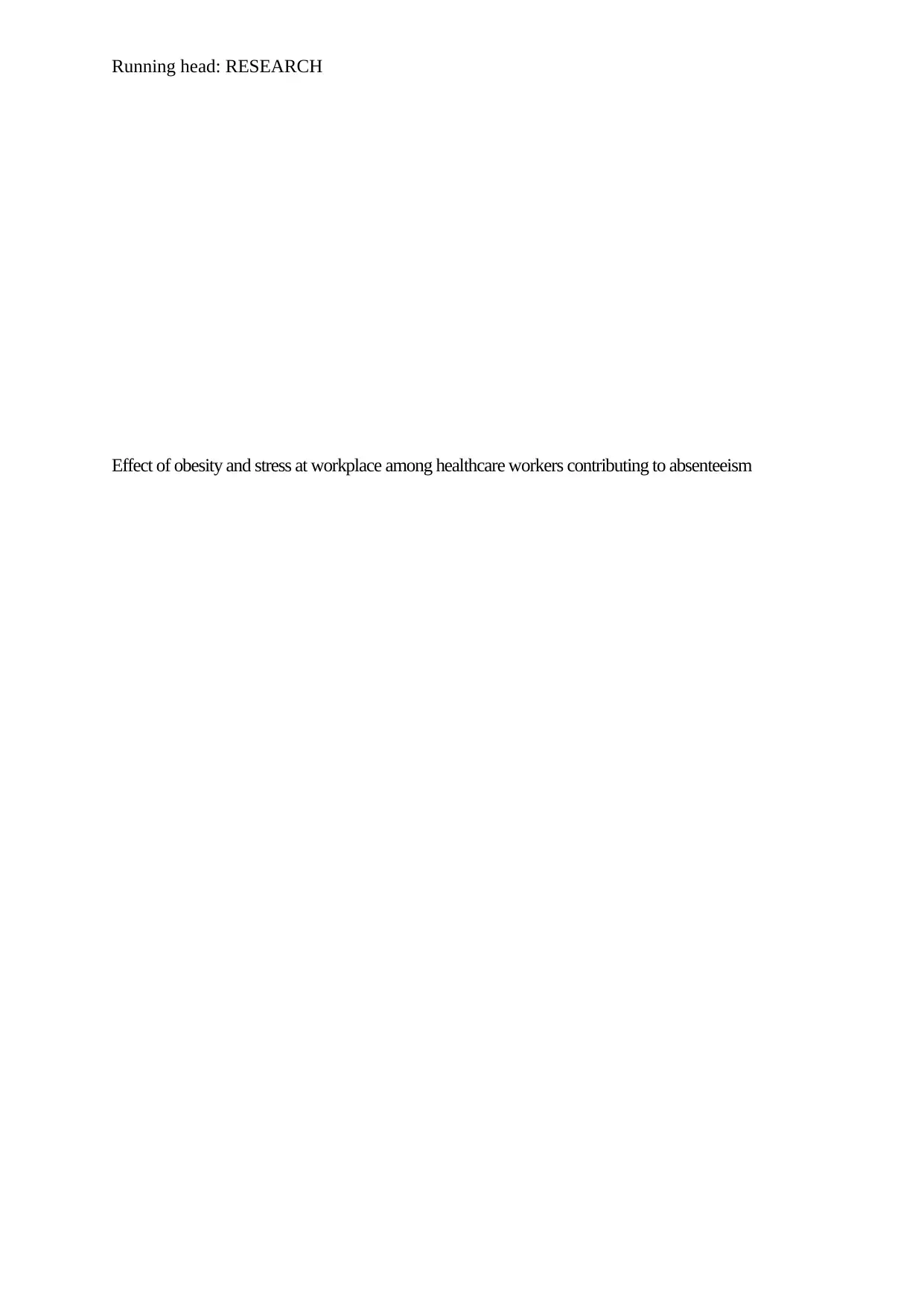
Running head: RESEARCH
Effect of obesity and stress at workplace among healthcare workers contributing to absenteeism
Effect of obesity and stress at workplace among healthcare workers contributing to absenteeism
Paraphrase This Document
Need a fresh take? Get an instant paraphrase of this document with our AI Paraphraser
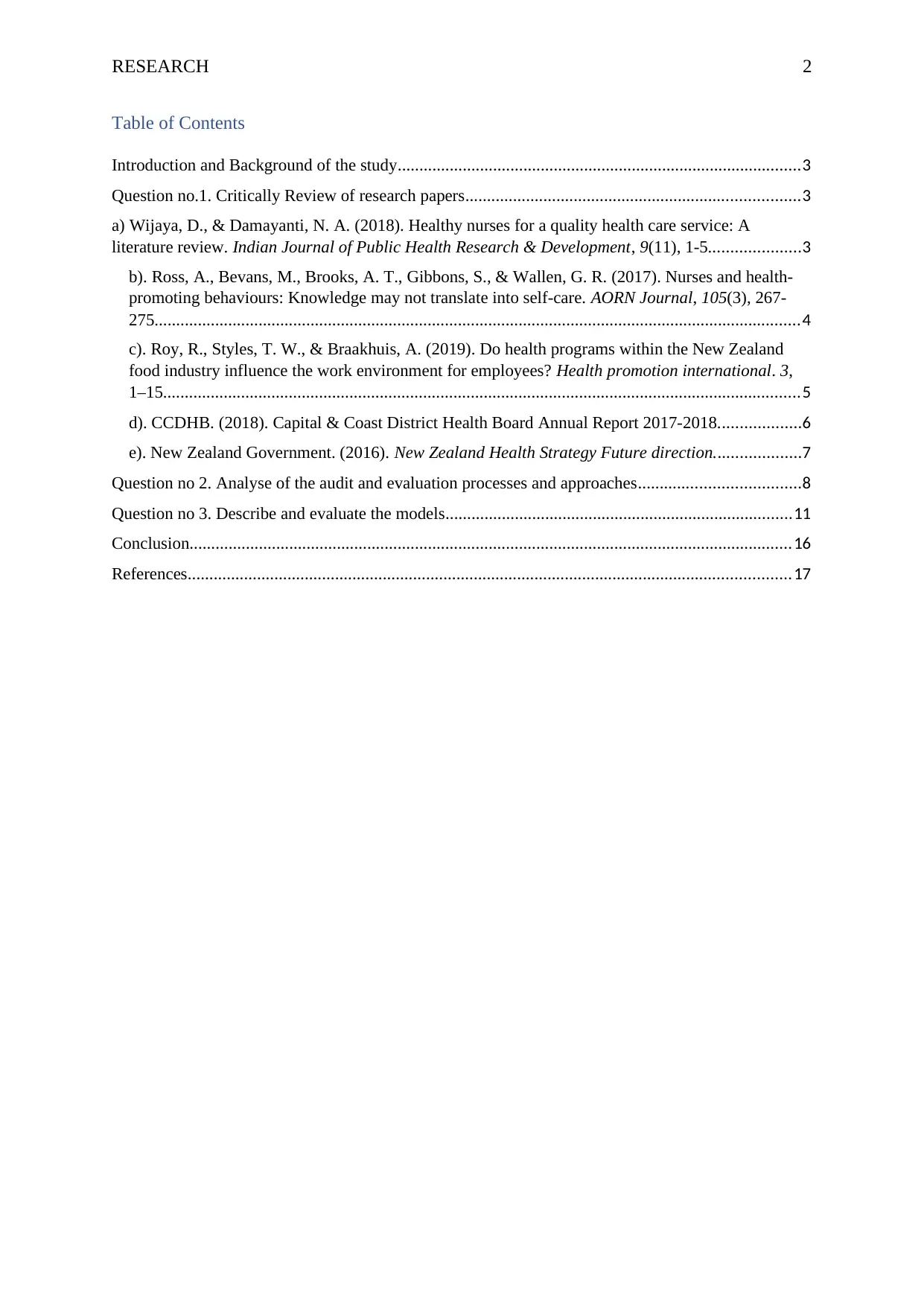
RESEARCH 2
Table of Contents
Introduction and Background of the study.............................................................................................3
Question no.1. Critically Review of research papers.............................................................................3
a) Wijaya, D., & Damayanti, N. A. (2018). Healthy nurses for a quality health care service: A
literature review. Indian Journal of Public Health Research & Development, 9(11), 1-5.....................3
b). Ross, A., Bevans, M., Brooks, A. T., Gibbons, S., & Wallen, G. R. (2017). Nurses and health-
promoting behaviours: Knowledge may not translate into self-care. AORN Journal, 105(3), 267-
275.....................................................................................................................................................4
c). Roy, R., Styles, T. W., & Braakhuis, A. (2019). Do health programs within the New Zealand
food industry influence the work environment for employees? Health promotion international. 3,
1–15...................................................................................................................................................5
d). CCDHB. (2018). Capital & Coast District Health Board Annual Report 2017-2018...................6
e). New Zealand Government. (2016). New Zealand Health Strategy Future direction....................7
Question no 2. Analyse of the audit and evaluation processes and approaches.....................................8
Question no 3. Describe and evaluate the models................................................................................11
Conclusion...........................................................................................................................................16
References...........................................................................................................................................17
Table of Contents
Introduction and Background of the study.............................................................................................3
Question no.1. Critically Review of research papers.............................................................................3
a) Wijaya, D., & Damayanti, N. A. (2018). Healthy nurses for a quality health care service: A
literature review. Indian Journal of Public Health Research & Development, 9(11), 1-5.....................3
b). Ross, A., Bevans, M., Brooks, A. T., Gibbons, S., & Wallen, G. R. (2017). Nurses and health-
promoting behaviours: Knowledge may not translate into self-care. AORN Journal, 105(3), 267-
275.....................................................................................................................................................4
c). Roy, R., Styles, T. W., & Braakhuis, A. (2019). Do health programs within the New Zealand
food industry influence the work environment for employees? Health promotion international. 3,
1–15...................................................................................................................................................5
d). CCDHB. (2018). Capital & Coast District Health Board Annual Report 2017-2018...................6
e). New Zealand Government. (2016). New Zealand Health Strategy Future direction....................7
Question no 2. Analyse of the audit and evaluation processes and approaches.....................................8
Question no 3. Describe and evaluate the models................................................................................11
Conclusion...........................................................................................................................................16
References...........................................................................................................................................17
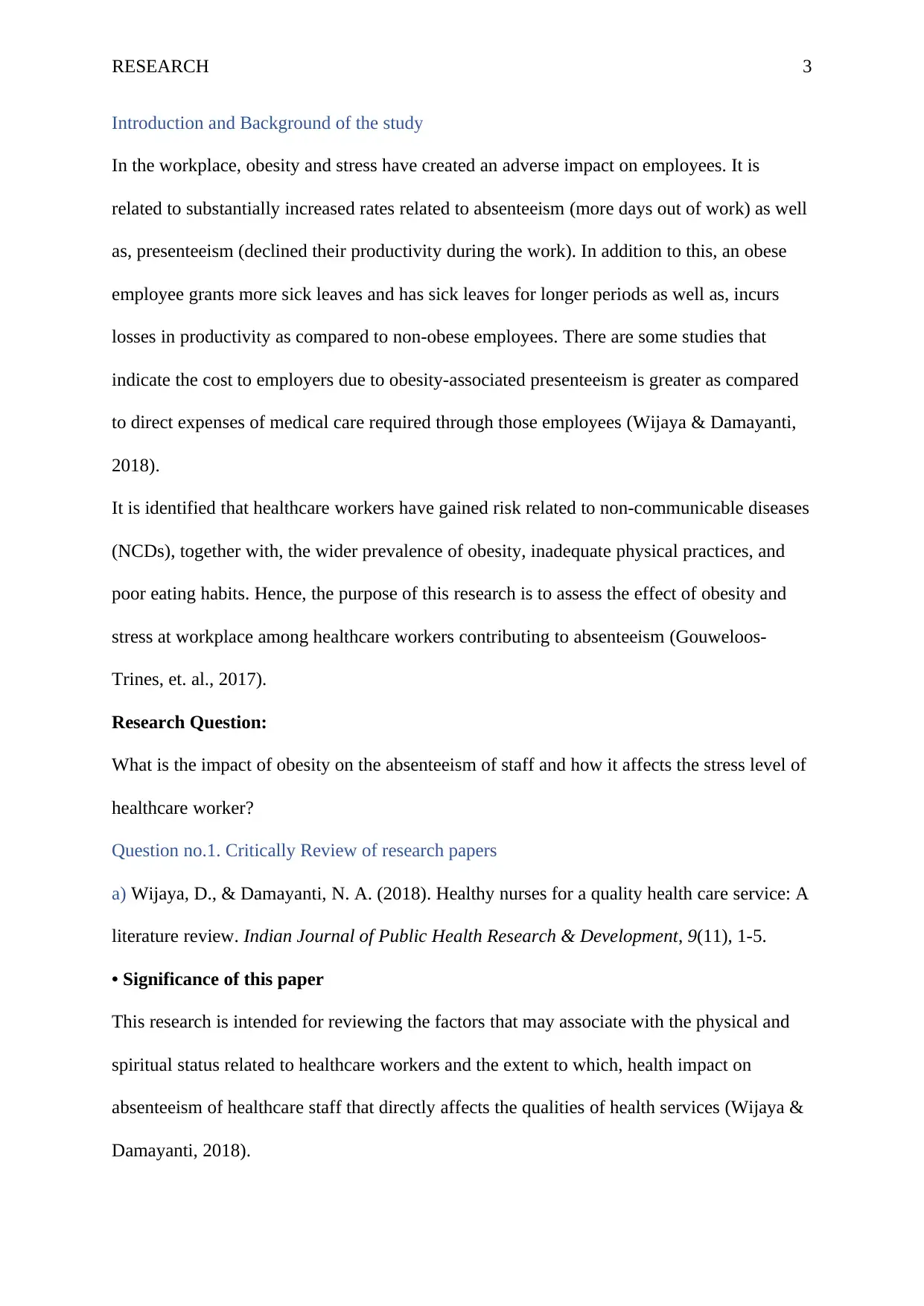
RESEARCH 3
Introduction and Background of the study
In the workplace, obesity and stress have created an adverse impact on employees. It is
related to substantially increased rates related to absenteeism (more days out of work) as well
as, presenteeism (declined their productivity during the work). In addition to this, an obese
employee grants more sick leaves and has sick leaves for longer periods as well as, incurs
losses in productivity as compared to non-obese employees. There are some studies that
indicate the cost to employers due to obesity-associated presenteeism is greater as compared
to direct expenses of medical care required through those employees (Wijaya & Damayanti,
2018).
It is identified that healthcare workers have gained risk related to non-communicable diseases
(NCDs), together with, the wider prevalence of obesity, inadequate physical practices, and
poor eating habits. Hence, the purpose of this research is to assess the effect of obesity and
stress at workplace among healthcare workers contributing to absenteeism (Gouweloos-
Trines, et. al., 2017).
Research Question:
What is the impact of obesity on the absenteeism of staff and how it affects the stress level of
healthcare worker?
Question no.1. Critically Review of research papers
a) Wijaya, D., & Damayanti, N. A. (2018). Healthy nurses for a quality health care service: A
literature review. Indian Journal of Public Health Research & Development, 9(11), 1-5.
• Significance of this paper
This research is intended for reviewing the factors that may associate with the physical and
spiritual status related to healthcare workers and the extent to which, health impact on
absenteeism of healthcare staff that directly affects the qualities of health services (Wijaya &
Damayanti, 2018).
Introduction and Background of the study
In the workplace, obesity and stress have created an adverse impact on employees. It is
related to substantially increased rates related to absenteeism (more days out of work) as well
as, presenteeism (declined their productivity during the work). In addition to this, an obese
employee grants more sick leaves and has sick leaves for longer periods as well as, incurs
losses in productivity as compared to non-obese employees. There are some studies that
indicate the cost to employers due to obesity-associated presenteeism is greater as compared
to direct expenses of medical care required through those employees (Wijaya & Damayanti,
2018).
It is identified that healthcare workers have gained risk related to non-communicable diseases
(NCDs), together with, the wider prevalence of obesity, inadequate physical practices, and
poor eating habits. Hence, the purpose of this research is to assess the effect of obesity and
stress at workplace among healthcare workers contributing to absenteeism (Gouweloos-
Trines, et. al., 2017).
Research Question:
What is the impact of obesity on the absenteeism of staff and how it affects the stress level of
healthcare worker?
Question no.1. Critically Review of research papers
a) Wijaya, D., & Damayanti, N. A. (2018). Healthy nurses for a quality health care service: A
literature review. Indian Journal of Public Health Research & Development, 9(11), 1-5.
• Significance of this paper
This research is intended for reviewing the factors that may associate with the physical and
spiritual status related to healthcare workers and the extent to which, health impact on
absenteeism of healthcare staff that directly affects the qualities of health services (Wijaya &
Damayanti, 2018).
⊘ This is a preview!⊘
Do you want full access?
Subscribe today to unlock all pages.

Trusted by 1+ million students worldwide
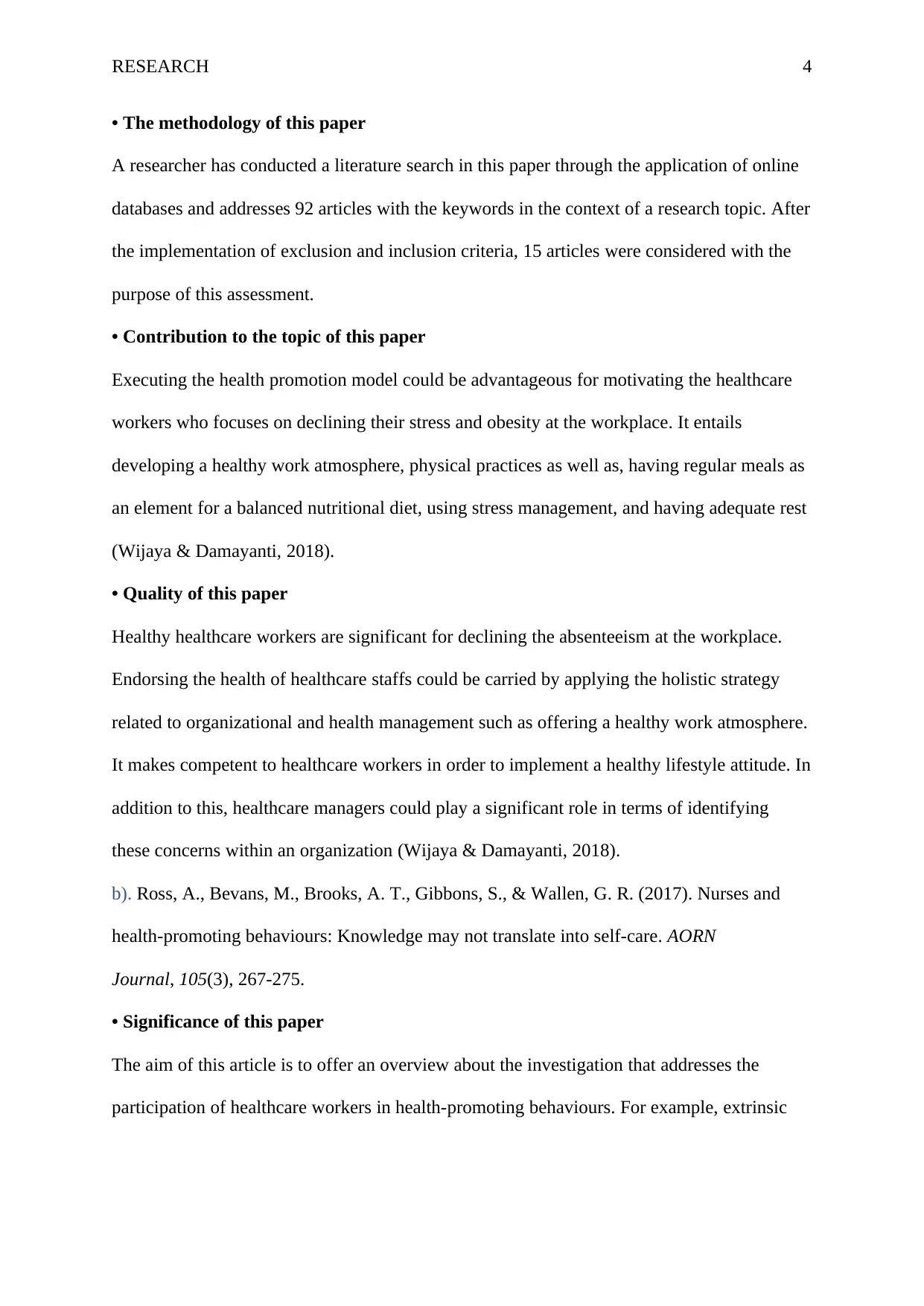
RESEARCH 4
• The methodology of this paper
A researcher has conducted a literature search in this paper through the application of online
databases and addresses 92 articles with the keywords in the context of a research topic. After
the implementation of exclusion and inclusion criteria, 15 articles were considered with the
purpose of this assessment.
• Contribution to the topic of this paper
Executing the health promotion model could be advantageous for motivating the healthcare
workers who focuses on declining their stress and obesity at the workplace. It entails
developing a healthy work atmosphere, physical practices as well as, having regular meals as
an element for a balanced nutritional diet, using stress management, and having adequate rest
(Wijaya & Damayanti, 2018).
• Quality of this paper
Healthy healthcare workers are significant for declining the absenteeism at the workplace.
Endorsing the health of healthcare staffs could be carried by applying the holistic strategy
related to organizational and health management such as offering a healthy work atmosphere.
It makes competent to healthcare workers in order to implement a healthy lifestyle attitude. In
addition to this, healthcare managers could play a significant role in terms of identifying
these concerns within an organization (Wijaya & Damayanti, 2018).
b). Ross, A., Bevans, M., Brooks, A. T., Gibbons, S., & Wallen, G. R. (2017). Nurses and
health-promoting behaviours: Knowledge may not translate into self-care. AORN
Journal, 105(3), 267-275.
• Significance of this paper
The aim of this article is to offer an overview about the investigation that addresses the
participation of healthcare workers in health-promoting behaviours. For example, extrinsic
• The methodology of this paper
A researcher has conducted a literature search in this paper through the application of online
databases and addresses 92 articles with the keywords in the context of a research topic. After
the implementation of exclusion and inclusion criteria, 15 articles were considered with the
purpose of this assessment.
• Contribution to the topic of this paper
Executing the health promotion model could be advantageous for motivating the healthcare
workers who focuses on declining their stress and obesity at the workplace. It entails
developing a healthy work atmosphere, physical practices as well as, having regular meals as
an element for a balanced nutritional diet, using stress management, and having adequate rest
(Wijaya & Damayanti, 2018).
• Quality of this paper
Healthy healthcare workers are significant for declining the absenteeism at the workplace.
Endorsing the health of healthcare staffs could be carried by applying the holistic strategy
related to organizational and health management such as offering a healthy work atmosphere.
It makes competent to healthcare workers in order to implement a healthy lifestyle attitude. In
addition to this, healthcare managers could play a significant role in terms of identifying
these concerns within an organization (Wijaya & Damayanti, 2018).
b). Ross, A., Bevans, M., Brooks, A. T., Gibbons, S., & Wallen, G. R. (2017). Nurses and
health-promoting behaviours: Knowledge may not translate into self-care. AORN
Journal, 105(3), 267-275.
• Significance of this paper
The aim of this article is to offer an overview about the investigation that addresses the
participation of healthcare workers in health-promoting behaviours. For example, extrinsic
Paraphrase This Document
Need a fresh take? Get an instant paraphrase of this document with our AI Paraphraser
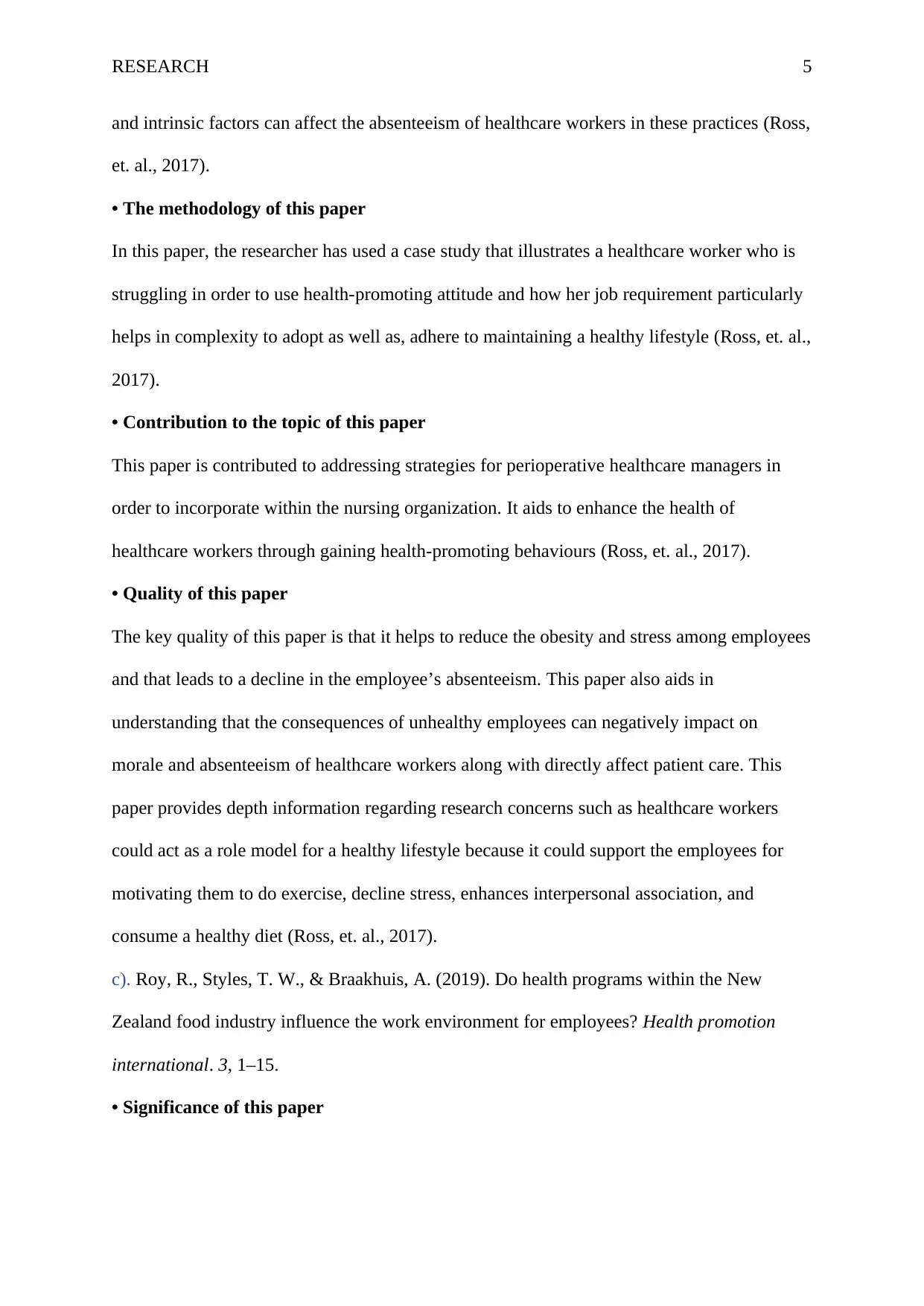
RESEARCH 5
and intrinsic factors can affect the absenteeism of healthcare workers in these practices (Ross,
et. al., 2017).
• The methodology of this paper
In this paper, the researcher has used a case study that illustrates a healthcare worker who is
struggling in order to use health-promoting attitude and how her job requirement particularly
helps in complexity to adopt as well as, adhere to maintaining a healthy lifestyle (Ross, et. al.,
2017).
• Contribution to the topic of this paper
This paper is contributed to addressing strategies for perioperative healthcare managers in
order to incorporate within the nursing organization. It aids to enhance the health of
healthcare workers through gaining health-promoting behaviours (Ross, et. al., 2017).
• Quality of this paper
The key quality of this paper is that it helps to reduce the obesity and stress among employees
and that leads to a decline in the employee’s absenteeism. This paper also aids in
understanding that the consequences of unhealthy employees can negatively impact on
morale and absenteeism of healthcare workers along with directly affect patient care. This
paper provides depth information regarding research concerns such as healthcare workers
could act as a role model for a healthy lifestyle because it could support the employees for
motivating them to do exercise, decline stress, enhances interpersonal association, and
consume a healthy diet (Ross, et. al., 2017).
c). Roy, R., Styles, T. W., & Braakhuis, A. (2019). Do health programs within the New
Zealand food industry influence the work environment for employees? Health promotion
international. 3, 1–15.
• Significance of this paper
and intrinsic factors can affect the absenteeism of healthcare workers in these practices (Ross,
et. al., 2017).
• The methodology of this paper
In this paper, the researcher has used a case study that illustrates a healthcare worker who is
struggling in order to use health-promoting attitude and how her job requirement particularly
helps in complexity to adopt as well as, adhere to maintaining a healthy lifestyle (Ross, et. al.,
2017).
• Contribution to the topic of this paper
This paper is contributed to addressing strategies for perioperative healthcare managers in
order to incorporate within the nursing organization. It aids to enhance the health of
healthcare workers through gaining health-promoting behaviours (Ross, et. al., 2017).
• Quality of this paper
The key quality of this paper is that it helps to reduce the obesity and stress among employees
and that leads to a decline in the employee’s absenteeism. This paper also aids in
understanding that the consequences of unhealthy employees can negatively impact on
morale and absenteeism of healthcare workers along with directly affect patient care. This
paper provides depth information regarding research concerns such as healthcare workers
could act as a role model for a healthy lifestyle because it could support the employees for
motivating them to do exercise, decline stress, enhances interpersonal association, and
consume a healthy diet (Ross, et. al., 2017).
c). Roy, R., Styles, T. W., & Braakhuis, A. (2019). Do health programs within the New
Zealand food industry influence the work environment for employees? Health promotion
international. 3, 1–15.
• Significance of this paper
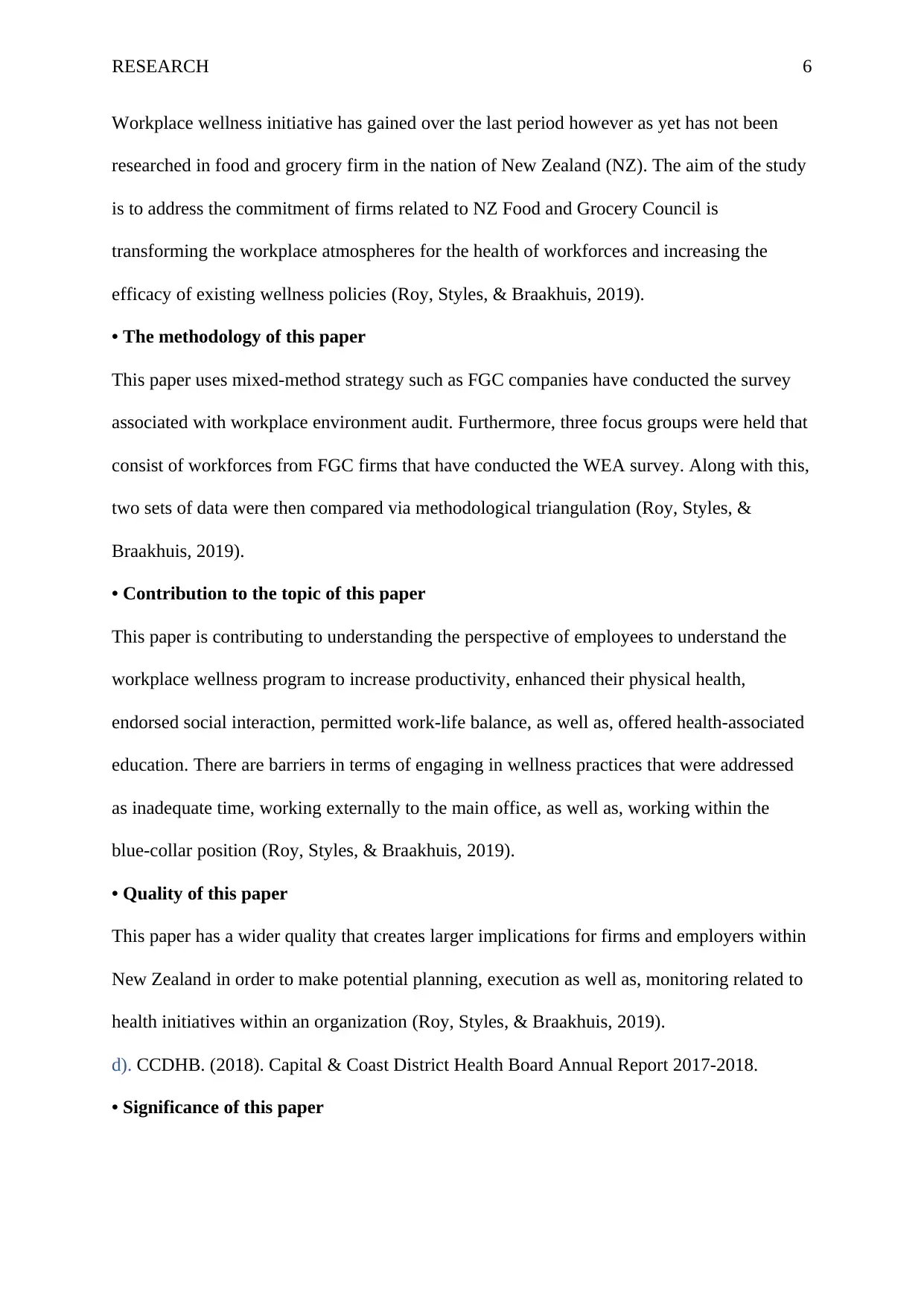
RESEARCH 6
Workplace wellness initiative has gained over the last period however as yet has not been
researched in food and grocery firm in the nation of New Zealand (NZ). The aim of the study
is to address the commitment of firms related to NZ Food and Grocery Council is
transforming the workplace atmospheres for the health of workforces and increasing the
efficacy of existing wellness policies (Roy, Styles, & Braakhuis, 2019).
• The methodology of this paper
This paper uses mixed-method strategy such as FGC companies have conducted the survey
associated with workplace environment audit. Furthermore, three focus groups were held that
consist of workforces from FGC firms that have conducted the WEA survey. Along with this,
two sets of data were then compared via methodological triangulation (Roy, Styles, &
Braakhuis, 2019).
• Contribution to the topic of this paper
This paper is contributing to understanding the perspective of employees to understand the
workplace wellness program to increase productivity, enhanced their physical health,
endorsed social interaction, permitted work-life balance, as well as, offered health-associated
education. There are barriers in terms of engaging in wellness practices that were addressed
as inadequate time, working externally to the main office, as well as, working within the
blue-collar position (Roy, Styles, & Braakhuis, 2019).
• Quality of this paper
This paper has a wider quality that creates larger implications for firms and employers within
New Zealand in order to make potential planning, execution as well as, monitoring related to
health initiatives within an organization (Roy, Styles, & Braakhuis, 2019).
d). CCDHB. (2018). Capital & Coast District Health Board Annual Report 2017-2018.
• Significance of this paper
Workplace wellness initiative has gained over the last period however as yet has not been
researched in food and grocery firm in the nation of New Zealand (NZ). The aim of the study
is to address the commitment of firms related to NZ Food and Grocery Council is
transforming the workplace atmospheres for the health of workforces and increasing the
efficacy of existing wellness policies (Roy, Styles, & Braakhuis, 2019).
• The methodology of this paper
This paper uses mixed-method strategy such as FGC companies have conducted the survey
associated with workplace environment audit. Furthermore, three focus groups were held that
consist of workforces from FGC firms that have conducted the WEA survey. Along with this,
two sets of data were then compared via methodological triangulation (Roy, Styles, &
Braakhuis, 2019).
• Contribution to the topic of this paper
This paper is contributing to understanding the perspective of employees to understand the
workplace wellness program to increase productivity, enhanced their physical health,
endorsed social interaction, permitted work-life balance, as well as, offered health-associated
education. There are barriers in terms of engaging in wellness practices that were addressed
as inadequate time, working externally to the main office, as well as, working within the
blue-collar position (Roy, Styles, & Braakhuis, 2019).
• Quality of this paper
This paper has a wider quality that creates larger implications for firms and employers within
New Zealand in order to make potential planning, execution as well as, monitoring related to
health initiatives within an organization (Roy, Styles, & Braakhuis, 2019).
d). CCDHB. (2018). Capital & Coast District Health Board Annual Report 2017-2018.
• Significance of this paper
⊘ This is a preview!⊘
Do you want full access?
Subscribe today to unlock all pages.

Trusted by 1+ million students worldwide
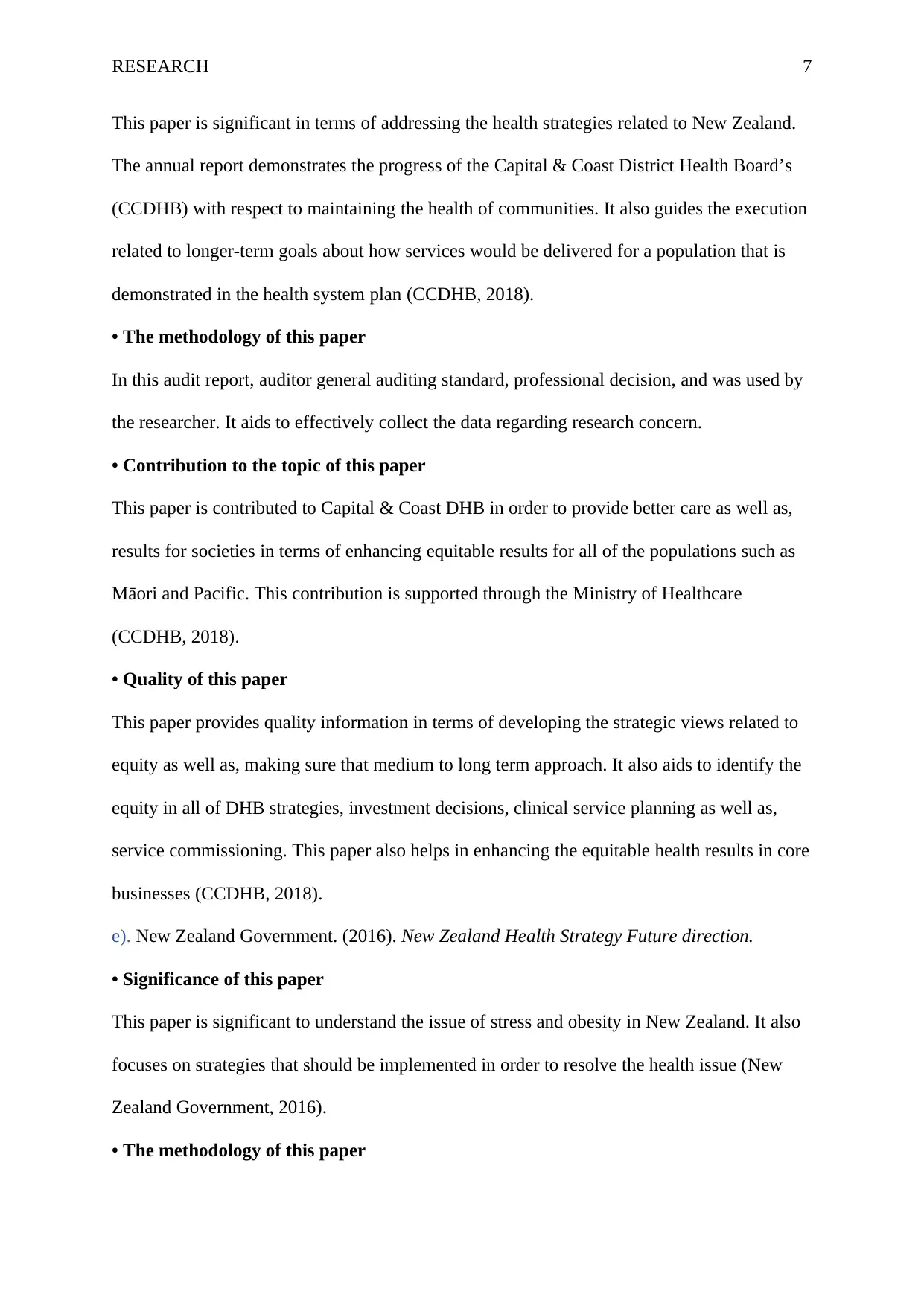
RESEARCH 7
This paper is significant in terms of addressing the health strategies related to New Zealand.
The annual report demonstrates the progress of the Capital & Coast District Health Board’s
(CCDHB) with respect to maintaining the health of communities. It also guides the execution
related to longer-term goals about how services would be delivered for a population that is
demonstrated in the health system plan (CCDHB, 2018).
• The methodology of this paper
In this audit report, auditor general auditing standard, professional decision, and was used by
the researcher. It aids to effectively collect the data regarding research concern.
• Contribution to the topic of this paper
This paper is contributed to Capital & Coast DHB in order to provide better care as well as,
results for societies in terms of enhancing equitable results for all of the populations such as
Māori and Pacific. This contribution is supported through the Ministry of Healthcare
(CCDHB, 2018).
• Quality of this paper
This paper provides quality information in terms of developing the strategic views related to
equity as well as, making sure that medium to long term approach. It also aids to identify the
equity in all of DHB strategies, investment decisions, clinical service planning as well as,
service commissioning. This paper also helps in enhancing the equitable health results in core
businesses (CCDHB, 2018).
e). New Zealand Government. (2016). New Zealand Health Strategy Future direction.
• Significance of this paper
This paper is significant to understand the issue of stress and obesity in New Zealand. It also
focuses on strategies that should be implemented in order to resolve the health issue (New
Zealand Government, 2016).
• The methodology of this paper
This paper is significant in terms of addressing the health strategies related to New Zealand.
The annual report demonstrates the progress of the Capital & Coast District Health Board’s
(CCDHB) with respect to maintaining the health of communities. It also guides the execution
related to longer-term goals about how services would be delivered for a population that is
demonstrated in the health system plan (CCDHB, 2018).
• The methodology of this paper
In this audit report, auditor general auditing standard, professional decision, and was used by
the researcher. It aids to effectively collect the data regarding research concern.
• Contribution to the topic of this paper
This paper is contributed to Capital & Coast DHB in order to provide better care as well as,
results for societies in terms of enhancing equitable results for all of the populations such as
Māori and Pacific. This contribution is supported through the Ministry of Healthcare
(CCDHB, 2018).
• Quality of this paper
This paper provides quality information in terms of developing the strategic views related to
equity as well as, making sure that medium to long term approach. It also aids to identify the
equity in all of DHB strategies, investment decisions, clinical service planning as well as,
service commissioning. This paper also helps in enhancing the equitable health results in core
businesses (CCDHB, 2018).
e). New Zealand Government. (2016). New Zealand Health Strategy Future direction.
• Significance of this paper
This paper is significant to understand the issue of stress and obesity in New Zealand. It also
focuses on strategies that should be implemented in order to resolve the health issue (New
Zealand Government, 2016).
• The methodology of this paper
Paraphrase This Document
Need a fresh take? Get an instant paraphrase of this document with our AI Paraphraser
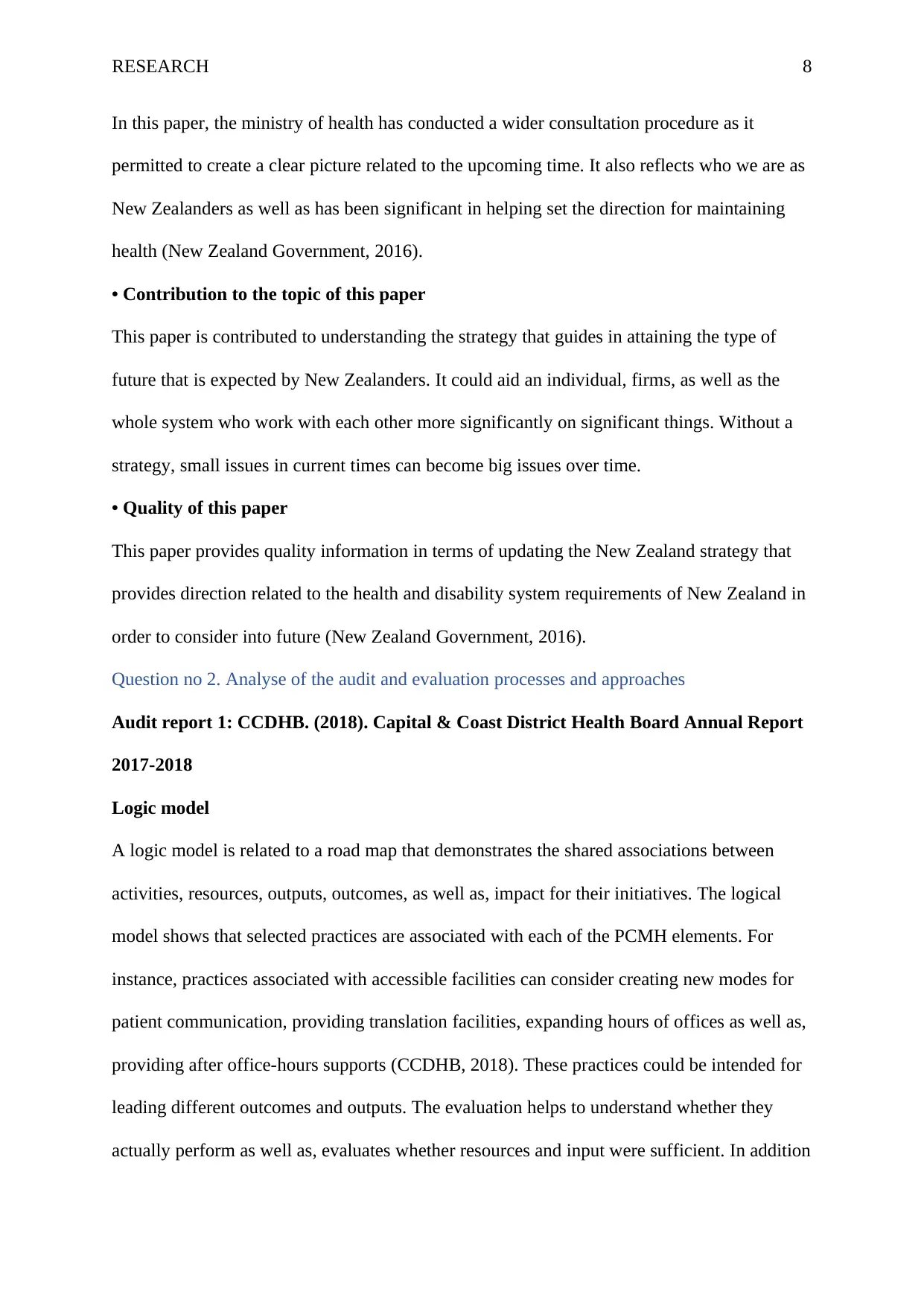
RESEARCH 8
In this paper, the ministry of health has conducted a wider consultation procedure as it
permitted to create a clear picture related to the upcoming time. It also reflects who we are as
New Zealanders as well as has been significant in helping set the direction for maintaining
health (New Zealand Government, 2016).
• Contribution to the topic of this paper
This paper is contributed to understanding the strategy that guides in attaining the type of
future that is expected by New Zealanders. It could aid an individual, firms, as well as the
whole system who work with each other more significantly on significant things. Without a
strategy, small issues in current times can become big issues over time.
• Quality of this paper
This paper provides quality information in terms of updating the New Zealand strategy that
provides direction related to the health and disability system requirements of New Zealand in
order to consider into future (New Zealand Government, 2016).
Question no 2. Analyse of the audit and evaluation processes and approaches
Audit report 1: CCDHB. (2018). Capital & Coast District Health Board Annual Report
2017-2018
Logic model
A logic model is related to a road map that demonstrates the shared associations between
activities, resources, outputs, outcomes, as well as, impact for their initiatives. The logical
model shows that selected practices are associated with each of the PCMH elements. For
instance, practices associated with accessible facilities can consider creating new modes for
patient communication, providing translation facilities, expanding hours of offices as well as,
providing after office-hours supports (CCDHB, 2018). These practices could be intended for
leading different outcomes and outputs. The evaluation helps to understand whether they
actually perform as well as, evaluates whether resources and input were sufficient. In addition
In this paper, the ministry of health has conducted a wider consultation procedure as it
permitted to create a clear picture related to the upcoming time. It also reflects who we are as
New Zealanders as well as has been significant in helping set the direction for maintaining
health (New Zealand Government, 2016).
• Contribution to the topic of this paper
This paper is contributed to understanding the strategy that guides in attaining the type of
future that is expected by New Zealanders. It could aid an individual, firms, as well as the
whole system who work with each other more significantly on significant things. Without a
strategy, small issues in current times can become big issues over time.
• Quality of this paper
This paper provides quality information in terms of updating the New Zealand strategy that
provides direction related to the health and disability system requirements of New Zealand in
order to consider into future (New Zealand Government, 2016).
Question no 2. Analyse of the audit and evaluation processes and approaches
Audit report 1: CCDHB. (2018). Capital & Coast District Health Board Annual Report
2017-2018
Logic model
A logic model is related to a road map that demonstrates the shared associations between
activities, resources, outputs, outcomes, as well as, impact for their initiatives. The logical
model shows that selected practices are associated with each of the PCMH elements. For
instance, practices associated with accessible facilities can consider creating new modes for
patient communication, providing translation facilities, expanding hours of offices as well as,
providing after office-hours supports (CCDHB, 2018). These practices could be intended for
leading different outcomes and outputs. The evaluation helps to understand whether they
actually perform as well as, evaluates whether resources and input were sufficient. In addition
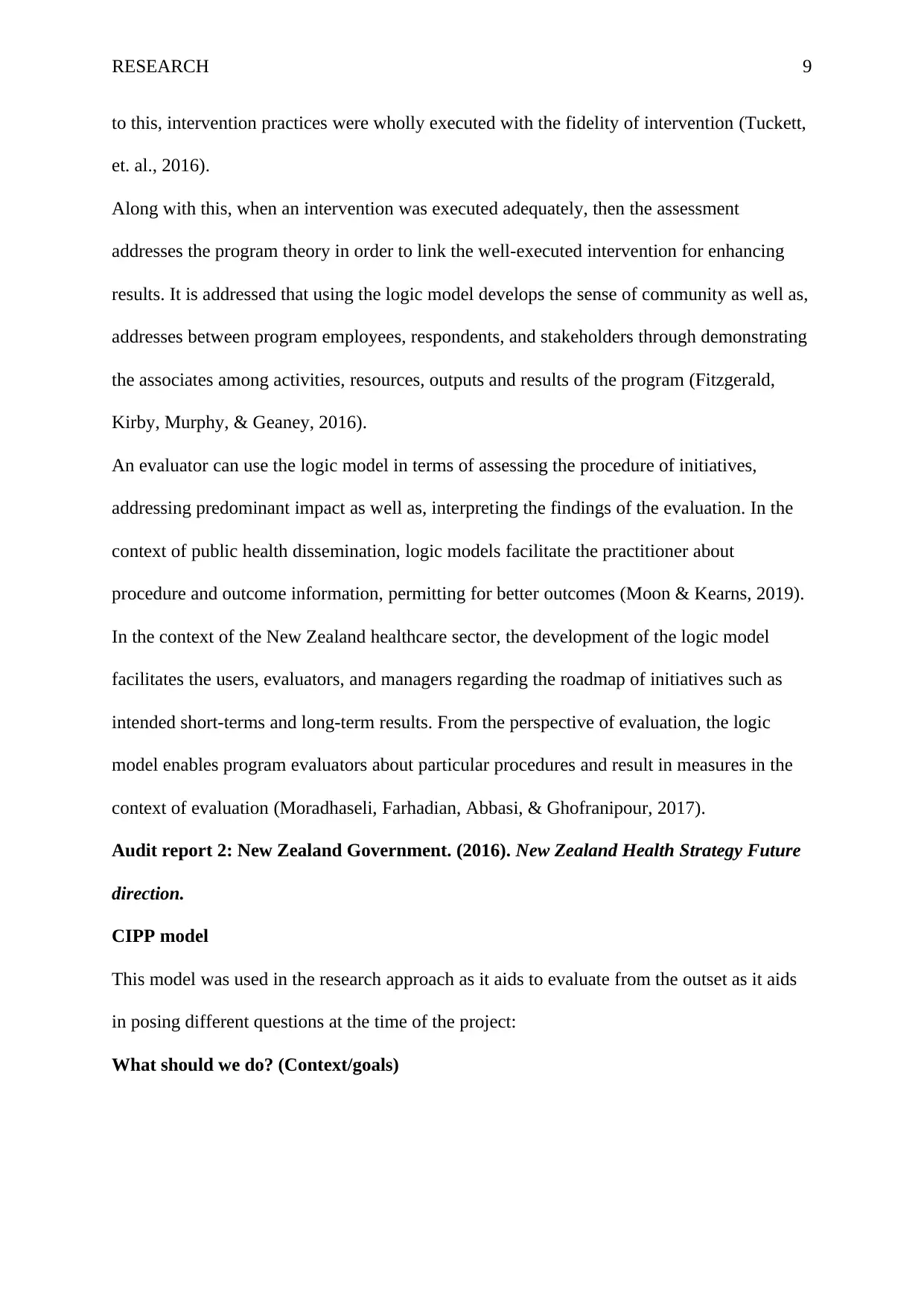
RESEARCH 9
to this, intervention practices were wholly executed with the fidelity of intervention (Tuckett,
et. al., 2016).
Along with this, when an intervention was executed adequately, then the assessment
addresses the program theory in order to link the well-executed intervention for enhancing
results. It is addressed that using the logic model develops the sense of community as well as,
addresses between program employees, respondents, and stakeholders through demonstrating
the associates among activities, resources, outputs and results of the program (Fitzgerald,
Kirby, Murphy, & Geaney, 2016).
An evaluator can use the logic model in terms of assessing the procedure of initiatives,
addressing predominant impact as well as, interpreting the findings of the evaluation. In the
context of public health dissemination, logic models facilitate the practitioner about
procedure and outcome information, permitting for better outcomes (Moon & Kearns, 2019).
In the context of the New Zealand healthcare sector, the development of the logic model
facilitates the users, evaluators, and managers regarding the roadmap of initiatives such as
intended short-terms and long-term results. From the perspective of evaluation, the logic
model enables program evaluators about particular procedures and result in measures in the
context of evaluation (Moradhaseli, Farhadian, Abbasi, & Ghofranipour, 2017).
Audit report 2: New Zealand Government. (2016). New Zealand Health Strategy Future
direction.
CIPP model
This model was used in the research approach as it aids to evaluate from the outset as it aids
in posing different questions at the time of the project:
What should we do? (Context/goals)
to this, intervention practices were wholly executed with the fidelity of intervention (Tuckett,
et. al., 2016).
Along with this, when an intervention was executed adequately, then the assessment
addresses the program theory in order to link the well-executed intervention for enhancing
results. It is addressed that using the logic model develops the sense of community as well as,
addresses between program employees, respondents, and stakeholders through demonstrating
the associates among activities, resources, outputs and results of the program (Fitzgerald,
Kirby, Murphy, & Geaney, 2016).
An evaluator can use the logic model in terms of assessing the procedure of initiatives,
addressing predominant impact as well as, interpreting the findings of the evaluation. In the
context of public health dissemination, logic models facilitate the practitioner about
procedure and outcome information, permitting for better outcomes (Moon & Kearns, 2019).
In the context of the New Zealand healthcare sector, the development of the logic model
facilitates the users, evaluators, and managers regarding the roadmap of initiatives such as
intended short-terms and long-term results. From the perspective of evaluation, the logic
model enables program evaluators about particular procedures and result in measures in the
context of evaluation (Moradhaseli, Farhadian, Abbasi, & Ghofranipour, 2017).
Audit report 2: New Zealand Government. (2016). New Zealand Health Strategy Future
direction.
CIPP model
This model was used in the research approach as it aids to evaluate from the outset as it aids
in posing different questions at the time of the project:
What should we do? (Context/goals)
⊘ This is a preview!⊘
Do you want full access?
Subscribe today to unlock all pages.

Trusted by 1+ million students worldwide
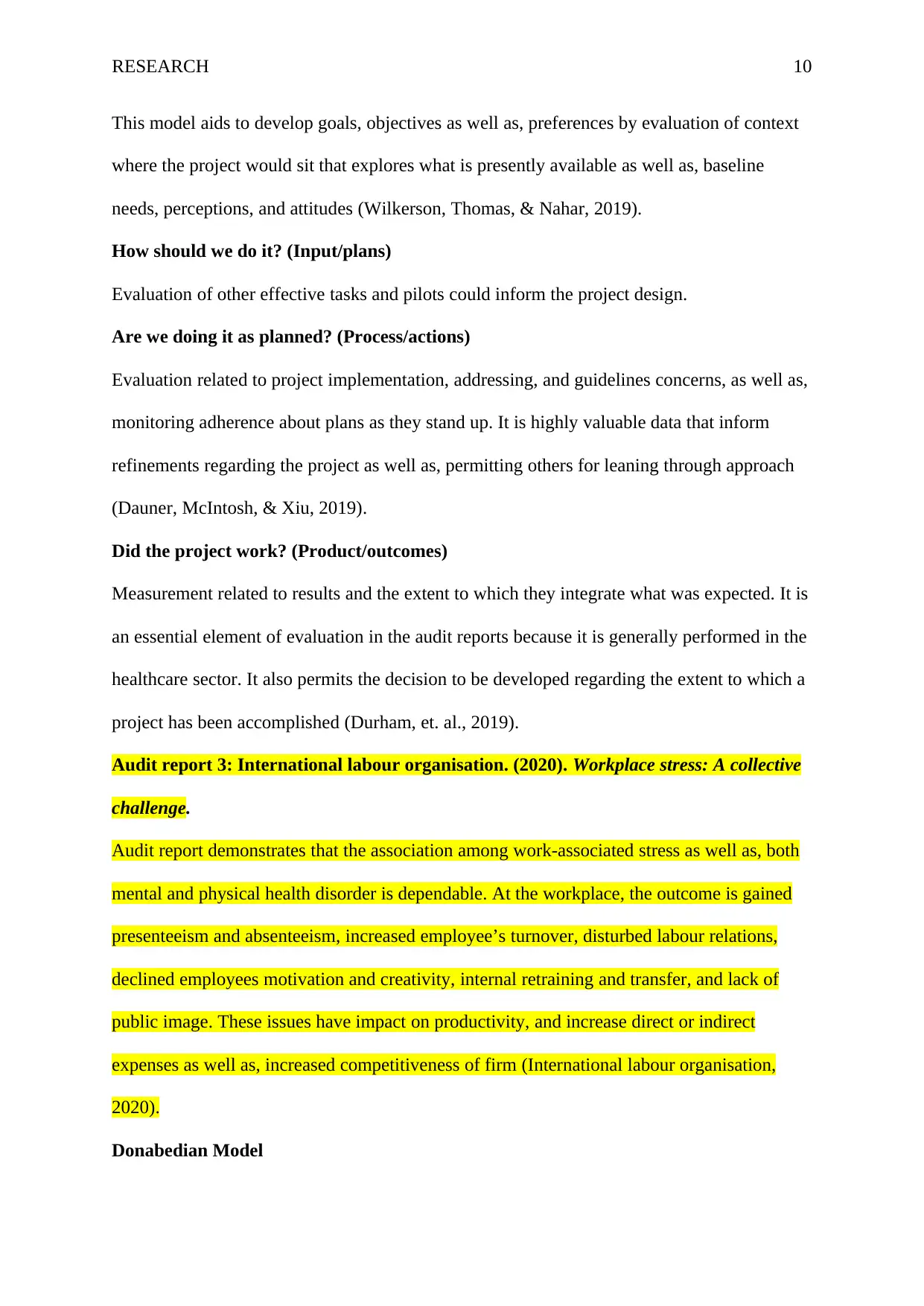
RESEARCH 10
This model aids to develop goals, objectives as well as, preferences by evaluation of context
where the project would sit that explores what is presently available as well as, baseline
needs, perceptions, and attitudes (Wilkerson, Thomas, & Nahar, 2019).
How should we do it? (Input/plans)
Evaluation of other effective tasks and pilots could inform the project design.
Are we doing it as planned? (Process/actions)
Evaluation related to project implementation, addressing, and guidelines concerns, as well as,
monitoring adherence about plans as they stand up. It is highly valuable data that inform
refinements regarding the project as well as, permitting others for leaning through approach
(Dauner, McIntosh, & Xiu, 2019).
Did the project work? (Product/outcomes)
Measurement related to results and the extent to which they integrate what was expected. It is
an essential element of evaluation in the audit reports because it is generally performed in the
healthcare sector. It also permits the decision to be developed regarding the extent to which a
project has been accomplished (Durham, et. al., 2019).
Audit report 3: International labour organisation. (2020). Workplace stress: A collective
challenge.
Audit report demonstrates that the association among work-associated stress as well as, both
mental and physical health disorder is dependable. At the workplace, the outcome is gained
presenteeism and absenteeism, increased employee’s turnover, disturbed labour relations,
declined employees motivation and creativity, internal retraining and transfer, and lack of
public image. These issues have impact on productivity, and increase direct or indirect
expenses as well as, increased competitiveness of firm (International labour organisation,
2020).
Donabedian Model
This model aids to develop goals, objectives as well as, preferences by evaluation of context
where the project would sit that explores what is presently available as well as, baseline
needs, perceptions, and attitudes (Wilkerson, Thomas, & Nahar, 2019).
How should we do it? (Input/plans)
Evaluation of other effective tasks and pilots could inform the project design.
Are we doing it as planned? (Process/actions)
Evaluation related to project implementation, addressing, and guidelines concerns, as well as,
monitoring adherence about plans as they stand up. It is highly valuable data that inform
refinements regarding the project as well as, permitting others for leaning through approach
(Dauner, McIntosh, & Xiu, 2019).
Did the project work? (Product/outcomes)
Measurement related to results and the extent to which they integrate what was expected. It is
an essential element of evaluation in the audit reports because it is generally performed in the
healthcare sector. It also permits the decision to be developed regarding the extent to which a
project has been accomplished (Durham, et. al., 2019).
Audit report 3: International labour organisation. (2020). Workplace stress: A collective
challenge.
Audit report demonstrates that the association among work-associated stress as well as, both
mental and physical health disorder is dependable. At the workplace, the outcome is gained
presenteeism and absenteeism, increased employee’s turnover, disturbed labour relations,
declined employees motivation and creativity, internal retraining and transfer, and lack of
public image. These issues have impact on productivity, and increase direct or indirect
expenses as well as, increased competitiveness of firm (International labour organisation,
2020).
Donabedian Model
Paraphrase This Document
Need a fresh take? Get an instant paraphrase of this document with our AI Paraphraser
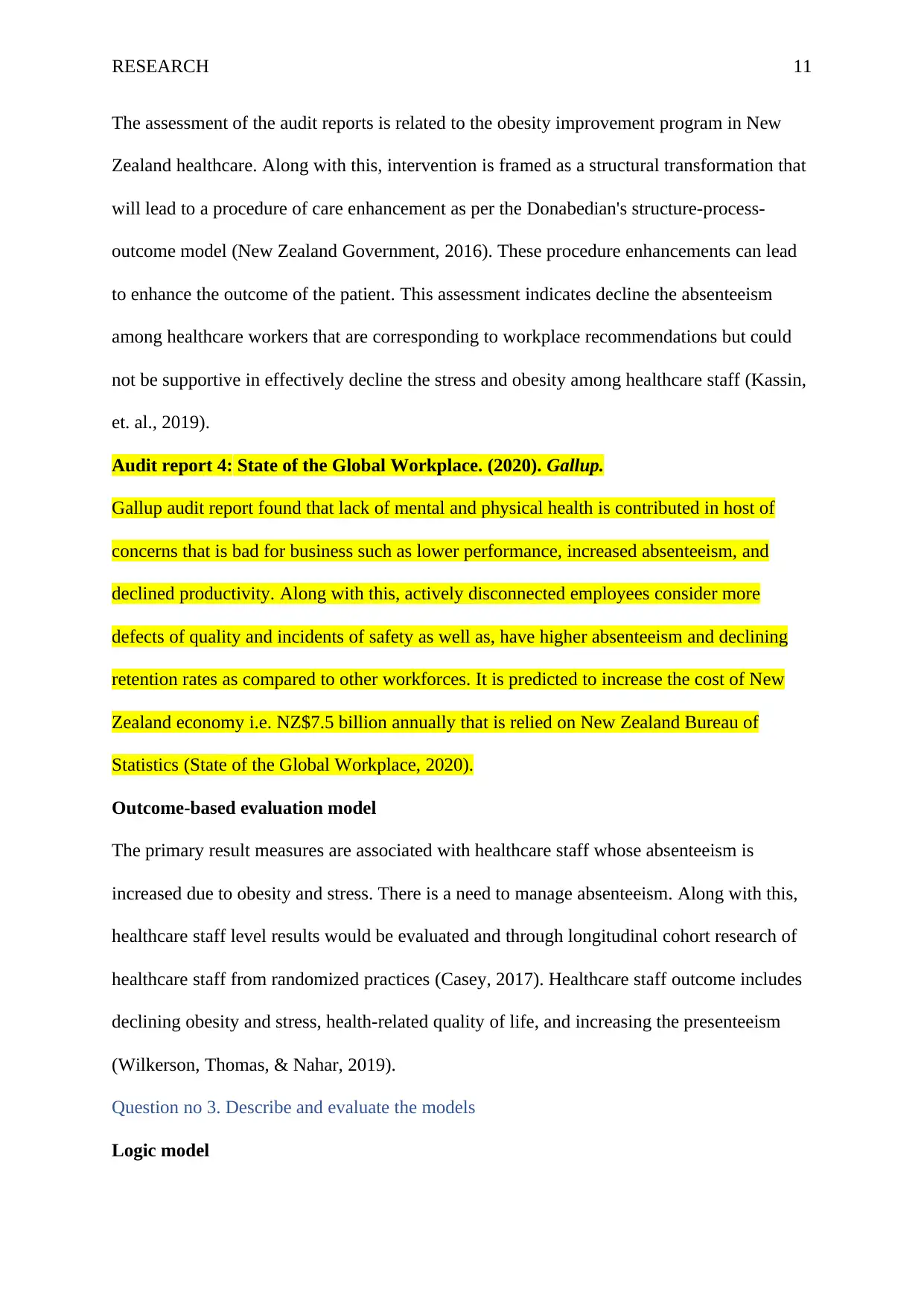
RESEARCH 11
The assessment of the audit reports is related to the obesity improvement program in New
Zealand healthcare. Along with this, intervention is framed as a structural transformation that
will lead to a procedure of care enhancement as per the Donabedian's structure-process-
outcome model (New Zealand Government, 2016). These procedure enhancements can lead
to enhance the outcome of the patient. This assessment indicates decline the absenteeism
among healthcare workers that are corresponding to workplace recommendations but could
not be supportive in effectively decline the stress and obesity among healthcare staff (Kassin,
et. al., 2019).
Audit report 4: State of the Global Workplace. (2020). Gallup.
Gallup audit report found that lack of mental and physical health is contributed in host of
concerns that is bad for business such as lower performance, increased absenteeism, and
declined productivity. Along with this, actively disconnected employees consider more
defects of quality and incidents of safety as well as, have higher absenteeism and declining
retention rates as compared to other workforces. It is predicted to increase the cost of New
Zealand economy i.e. NZ$7.5 billion annually that is relied on New Zealand Bureau of
Statistics (State of the Global Workplace, 2020).
Outcome-based evaluation model
The primary result measures are associated with healthcare staff whose absenteeism is
increased due to obesity and stress. There is a need to manage absenteeism. Along with this,
healthcare staff level results would be evaluated and through longitudinal cohort research of
healthcare staff from randomized practices (Casey, 2017). Healthcare staff outcome includes
declining obesity and stress, health-related quality of life, and increasing the presenteeism
(Wilkerson, Thomas, & Nahar, 2019).
Question no 3. Describe and evaluate the models
Logic model
The assessment of the audit reports is related to the obesity improvement program in New
Zealand healthcare. Along with this, intervention is framed as a structural transformation that
will lead to a procedure of care enhancement as per the Donabedian's structure-process-
outcome model (New Zealand Government, 2016). These procedure enhancements can lead
to enhance the outcome of the patient. This assessment indicates decline the absenteeism
among healthcare workers that are corresponding to workplace recommendations but could
not be supportive in effectively decline the stress and obesity among healthcare staff (Kassin,
et. al., 2019).
Audit report 4: State of the Global Workplace. (2020). Gallup.
Gallup audit report found that lack of mental and physical health is contributed in host of
concerns that is bad for business such as lower performance, increased absenteeism, and
declined productivity. Along with this, actively disconnected employees consider more
defects of quality and incidents of safety as well as, have higher absenteeism and declining
retention rates as compared to other workforces. It is predicted to increase the cost of New
Zealand economy i.e. NZ$7.5 billion annually that is relied on New Zealand Bureau of
Statistics (State of the Global Workplace, 2020).
Outcome-based evaluation model
The primary result measures are associated with healthcare staff whose absenteeism is
increased due to obesity and stress. There is a need to manage absenteeism. Along with this,
healthcare staff level results would be evaluated and through longitudinal cohort research of
healthcare staff from randomized practices (Casey, 2017). Healthcare staff outcome includes
declining obesity and stress, health-related quality of life, and increasing the presenteeism
(Wilkerson, Thomas, & Nahar, 2019).
Question no 3. Describe and evaluate the models
Logic model
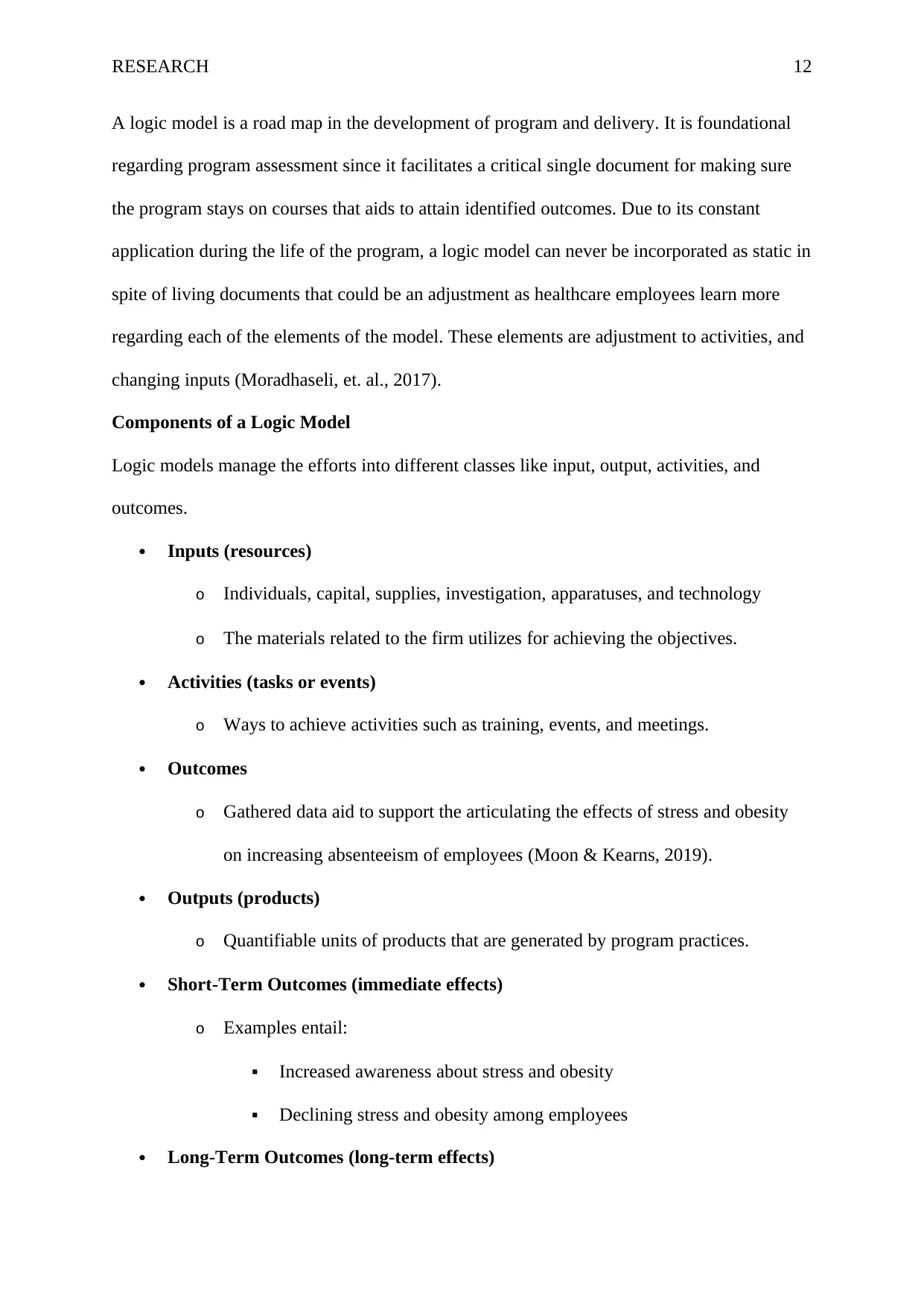
RESEARCH 12
A logic model is a road map in the development of program and delivery. It is foundational
regarding program assessment since it facilitates a critical single document for making sure
the program stays on courses that aids to attain identified outcomes. Due to its constant
application during the life of the program, a logic model can never be incorporated as static in
spite of living documents that could be an adjustment as healthcare employees learn more
regarding each of the elements of the model. These elements are adjustment to activities, and
changing inputs (Moradhaseli, et. al., 2017).
Components of a Logic Model
Logic models manage the efforts into different classes like input, output, activities, and
outcomes.
Inputs (resources)
o Individuals, capital, supplies, investigation, apparatuses, and technology
o The materials related to the firm utilizes for achieving the objectives.
Activities (tasks or events)
o Ways to achieve activities such as training, events, and meetings.
Outcomes
o Gathered data aid to support the articulating the effects of stress and obesity
on increasing absenteeism of employees (Moon & Kearns, 2019).
Outputs (products)
o Quantifiable units of products that are generated by program practices.
Short-Term Outcomes (immediate effects)
o Examples entail:
Increased awareness about stress and obesity
Declining stress and obesity among employees
Long-Term Outcomes (long-term effects)
A logic model is a road map in the development of program and delivery. It is foundational
regarding program assessment since it facilitates a critical single document for making sure
the program stays on courses that aids to attain identified outcomes. Due to its constant
application during the life of the program, a logic model can never be incorporated as static in
spite of living documents that could be an adjustment as healthcare employees learn more
regarding each of the elements of the model. These elements are adjustment to activities, and
changing inputs (Moradhaseli, et. al., 2017).
Components of a Logic Model
Logic models manage the efforts into different classes like input, output, activities, and
outcomes.
Inputs (resources)
o Individuals, capital, supplies, investigation, apparatuses, and technology
o The materials related to the firm utilizes for achieving the objectives.
Activities (tasks or events)
o Ways to achieve activities such as training, events, and meetings.
Outcomes
o Gathered data aid to support the articulating the effects of stress and obesity
on increasing absenteeism of employees (Moon & Kearns, 2019).
Outputs (products)
o Quantifiable units of products that are generated by program practices.
Short-Term Outcomes (immediate effects)
o Examples entail:
Increased awareness about stress and obesity
Declining stress and obesity among employees
Long-Term Outcomes (long-term effects)
⊘ This is a preview!⊘
Do you want full access?
Subscribe today to unlock all pages.

Trusted by 1+ million students worldwide
1 out of 19
Related Documents
Your All-in-One AI-Powered Toolkit for Academic Success.
+13062052269
info@desklib.com
Available 24*7 on WhatsApp / Email
![[object Object]](/_next/static/media/star-bottom.7253800d.svg)
Unlock your academic potential
Copyright © 2020–2025 A2Z Services. All Rights Reserved. Developed and managed by ZUCOL.





